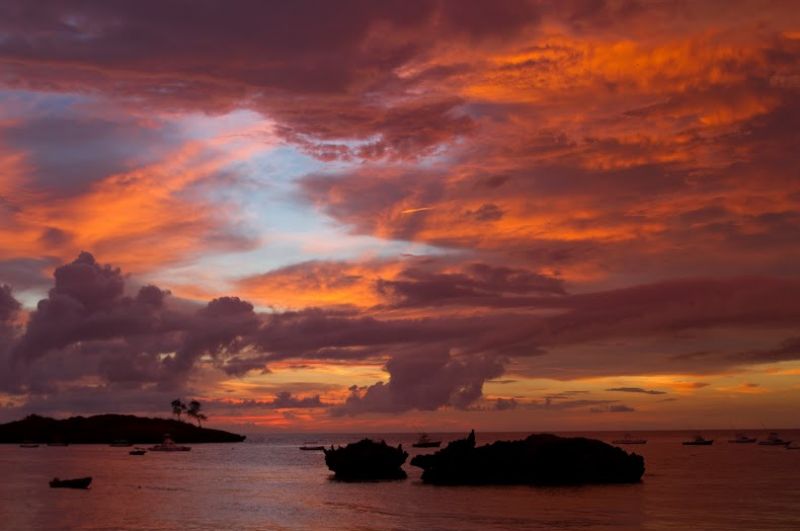A quintessential tropical paradise; with thousands of palm trees leaning out across broad, white, pristine sand beaches merging with turquoise waters like inseparable lovers, canoes anchored in crystal clear lagoons and odd coral islands embellished with large swathes of sea kelp in low tide – Oh! These are the places you see in exotic travel magazines. And beyond the beaches is a Kenyan village, in all its noisy muddle, slow paced life, huts of mud and thatched roof and children calling out Jambo. And then at affordable distance is one of the last surviving coastral tropical forests and the vestiges of an old swahilian civilization standing in eerie ruins among the tropical forests.
Welcome to Watamu, a small sleepy town, where number of resorts could outnumber the houses, located some 100 Kms from Mombasa, Kenya’s second biggest city and an important trade center.
Watamu was a serendipity, I had made my mind to set off for Diani beach, took an overnight bus from Nairobi to Mombasa, reached the matatu (bus) stand and learnt that matatu for Diani was to come about an hour later. There was a guy calling out to passengers for Malindi, the travel bug bit me, plans changed, remodeled or devised and I set off for Malindi. As I reached Mtwapa, I had the first glimpse of the white beaches and as I reached Watamu, and saw the metal board reading ‘Gedi Ruins’, I knew I was destined to be here.
I know a thought of a lesson on Kenyan history at Gedis stopped me, but the sight of the unspoilt, snow white sands shelving into aquamarine lagoon behind the reef, compelled me to stay. With every step into my hotel The Temple Point, which has a private beach on one side and mangrove forests on the other; I was getting assured of my pleasant stay.
I started my day with Gedi ruins, reserving the exploration of beach for the evening. The ruins of some 1400 or 1500s, quite run down, are like a closed book on Kenya whose chapters have not been read. There is no recorded history of Gedi ruins, but enough of the ruins were left that it was easy to see how the buildings were laid laid out: the different courts in the palace, the rooms in the houses, and the separate women’s area in the mosque. An extra bonus to Gedi ruins was a hike in the tropical forests, under the shade of tall trees, giving audience to the screeches of sykes monkey or spotting the odd looking elephant shrew (which is neither a shrew and obviously nor an elephant). There were families of monkeys everywhere and I did spot the rare golden-rumped elephant shrews. The have a golden rump and a snout like elephants, thought I didn’t get a good enough look to really see the snout, but the golden rump was clear and enough to make me come to a conclusion of what I had spotted.
As you step out of the ruins, a wooden board with ‘Kipepeo farm’ written on it directs you to a Butterfly Park, that’s like a dessert with an Italian meal. Combine the two and you have a perfect recipe of a leisurely spent evening in Watamu.
Gedi ruins was just a start, the real gem in Watamu’s kitty is the beach, with coral rocks poking up through pellucid waters. My first memory in the Watamu beach is of walking on the soft white sand counting the different shades of blue of water before me, as wind caressed my soul and seagulls whispered in my ears. Pristine sand beach and water as blue as it’s been in my dreams. Next door to my hotel was Watamu Marine National Park, a perfect ‘getting away from all’ option. Take tickets, hire a boat and set off for a ride for a journey so beautifully addictive, which you can only imagine in dreams. Sailing through the coral rocks, on waters so clear you can see the base of the ocean, schools of sergeant and parrot fish, overlooking two beautiful inlets, Turtle Bay and Blue Lagoon and the bluish green sea, stretching upto the horizon dotted with unnamed, unmanned islets. Stretching upto three miles into the sea, the marine national park houses some caves at its southern end, housing a collection of very large groupers or giant rock cod. I was unlucky and couldn’t find them, but to find them you need to search the tunnels, running under the caves and you might be lucky to spot these placid monsters of about six feet, gaping their mouth, fringed with tiny fish.
We sailed further, only to look for the best spots to snorkel. Watamu offers an excellent place to take up scuba-diving, and you can even swim with whale sharks at some times of the year. Having snorkeled and lulled by the surf and ocean breeze, shuffling around my broad shorts and linen shirt unbuttoned down to my navel, I came back to the beach, to slouch into a chair, and enjoy the sun and let the cool, moist laden breeze caress me.
I had reserved a stroll in the town for the evening and a visit to the snake farm and a sail to Mida Creek mangrove forests for the next day. It was time for a cozy walk and treating myself to wood oven pizza and giving audience to shouts of “Buon viaggis!” of some Italian tourists with obvious espressos with them.
In the evening, I busied myself in some spot shopping in the Watamu village. Though by every standard sleepy and quaint, the village offers some bright spots for good shopping of handicrafts. Though it may lack the traditional charm of Lamu or the flamboyance of Malindi, this quaint town offers a hassle free, relaxed experience; to steal a chance to drop by at the settlement of bajuni community (fishermen) and spend some time with them listening to the stories that take you to as back as 1960s when a small part of the reef was blasted to make way for a dock for the fishing boats and reef plots were leased to European settlers especially to Italians.
A drunken night was awaiting me, silver moon and a streak of light on the ocean. The cold breeze whispered in my ears as I walked on the beach, now taken over by dull coloured species of crabs.
The next day I was off to some incredible experience at the Bio-Ken Snake Farm. Located just 5 kms from Watamu, Bio-Ken is a research center which deals with reptiles, especially snakes and snake-bite and houses the largest collection of snakes in East Africa. This place which is quite scientifically managed allows you to hold snakes and also learn the science of venom collection and its advantages in medical science. I personally recommend this place for the sort of scientific and natural exposure it provides. Holding a snake in hand is an experience that can find few parallels.
I had reserved my noon and evening for a boat ride to the mangrove forests of Mida Creek. A mystery laden, river riddles region of shifting tides, Mida Creek defines the off the track place in this touristy town. Dipping into the forests in smaller boats is a great taste and idea to enjoy the serenity of the place. An added attraction are huge flocks of flamingos and cranes. The salty, shallow waters are great place for growth of algae which attracts not just these birds but also schools of turtles, smaller fish and thus schools of dolphins too. Dolphins visit this place around September.
Our journey started around 3 in the afternoon, Hotel Temple Point being located on the tip of the Creek is an ideal place to book a boat. From the very beginning the omens were good, I was lucky to spot tiger eels as the boat was getting readied for the journey. Five minutes into the water and we had an unbelievable spectacle before us; the muffled thrum of the boat was the only sound to be heard and before us were trees emerging eerily, with their latticed roots holding themselves in this kingdom of tides. This seemingly endless landscape of mangrove islets appeared a home of apparitions, inhabited by shapes and shadows, half guessed at. A lone egret took a flight; slicing its way through the comforted air of the ocean and for a moment I felt like navigating through the lungs. Two days, two different shades of this place, from turquoise clarity to riddled murkiness, watamu had continued to amaze me. Scanning the shrouded forests, I was studying the unique biotic balance of the mangrove habitat. Roots that grow upwards from the ground to breathe and seeds that germinate while on tree and falls on ground as a sapling; Mangroves have an inimitable adaptation strategy.
Gradually the sun was burning off its last reserves of fuel, and with it we were nearing the faunal hotspots of the creek. From a distance a row of bright pink was visible, and for a person who lives in perpetual hangover of flamingos, it wasn’t difficult to guess the source. I was on it before being told, completely missing the turtles who had come on surface to fill their lungs again to be back in water for another 8-10 hours. I only had the pink in mind, maddening me with the ecstasy. And as we approached, the thrum of boat that had by now, seemed a music, killing the silence of the creek, did the unwanted. The flock flew before it could be photographed. But any flamingo lover would know that they take a complete round of the place to return to the same spot. They returned for some nice shots, before we took a turn to be in the forests on smaller boats.
It was evening when I returned, I looked at the sea again from my room; it looked a moonlit gem, the dull coloured crabs would have come out to dine on the nutrients left by the receding sea. I felt the pain of leaving this place the next day in the shrieks of the breeze that blew. I looked at the pristine beach and then at the creek, which would still be breathing in and out in drips, and then at the moon. Hope I could hold all these in my kerchief and carry back home with me.













